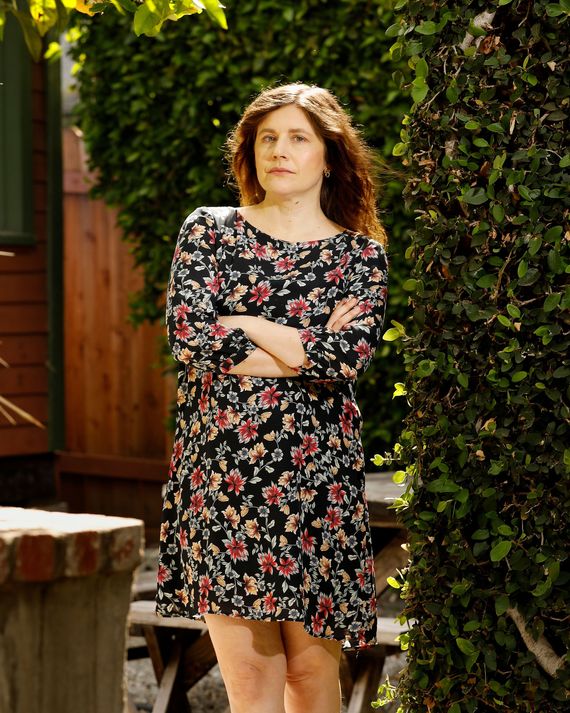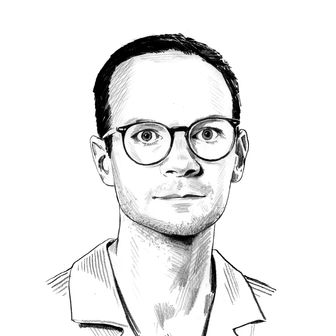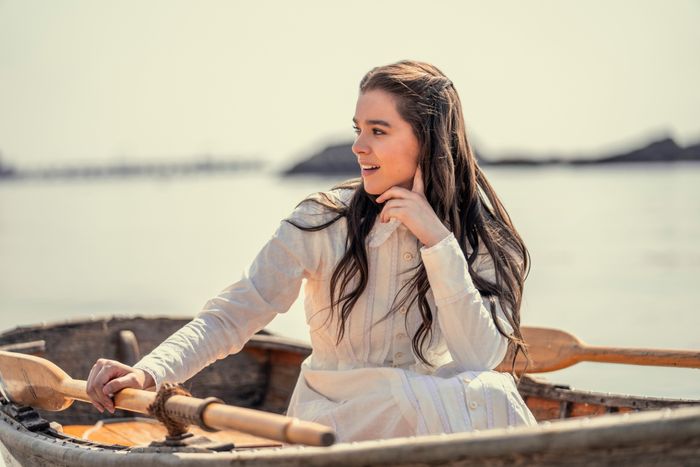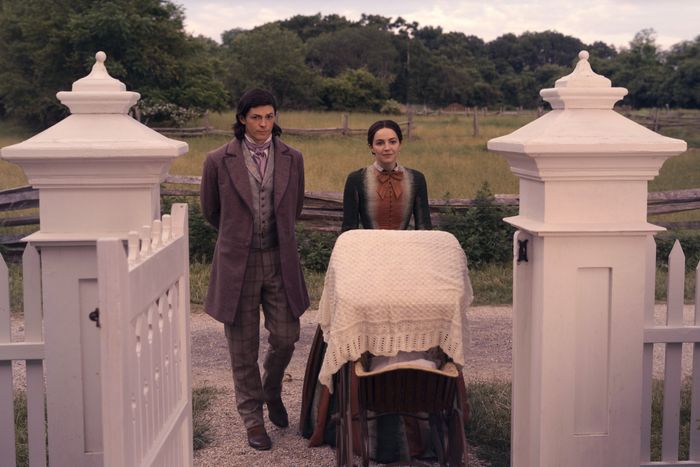
After three seasons of depicting a young Emily Dickinson’s life in the small town of Amherst, Massachusetts, Dickinson’s series finale ends in the wide-open space of her imagination. In the final scenes of the irreverent and anachronistic — and yet deeply felt and closely researched — Apple TV+ comedy, Emily designs the white dress that is closely associated with Dickinson’s image as a poet and her reputation as a later-in-life hermit. The Civil War, which has defined much of the show’s third season, is over, and her correspondent and key, well, artistic encourager, Thomas Wentworth Higginson, has come to see her. But Emily stays upstairs, and in a montage, we watch her cycle through mundane household tasks like watering her plants and knitting as the seasons change. Though it seems she’s confined to her home, it’s clear her creativity is whirring, and we hear snippets of her poetry in voiceover. Then, as Emily stares at a painting of a frigate, she appears on a beach, in that white dress she designed, playing with her dog. Evoking the Dickinson poem, “I started Early – Took my Dog,” she sees mermaids calling for her, gets into a little boat, and rows toward them.
The show ends not with a Dickinson quote, but with Emily saying, in voice-over, “Wait for me, I’m coming.” In the mind of the series’s creator Alena Smith, that moment is supposed to speak to many time periods at once. On one level, Emily is addressing the mermaids, who represent all the poems the character is yet to write. “She’s saying, ‘Inspiration, don’t leave, I’m going to find you all,’” Smith told me over Zoom. There’s also the fact that those poems would not be fully appreciated until years after Dickinson’s death. The people who are waiting are really her audience. “This has been a show about people whose influence and integrity has not yet been fully recognized by the master narratives of history,” Smith said. “It’s also about everybody 40 and younger who knows, right now, that the future is going to be different from the past, and summoning the bravery it takes for all of us to keep rowing our little ships out there.”
That layered moment is the epitome of what Smith has tried to bake into Dickinson from its inception. The series is simultaneously about a young woman’s coming of age in the 19th century, and what it means to come of age in the present — the overlapping resonances of the 1850s and 1860s and the 2010s and 2020s, and the ways in which female artistry is often misunderstood or simply overlooked. With the complete, three-season version of the show now released, Smith talked through that final sequence, the show’s depiction of the Civil War, and the complicated notion of hope.
How did you decide that sequence in the finale, of Emily seemingly journeying off into the world of her own poetry, would be the last moments of the show?
These three seasons of Dickinson are one story and one vision because it is my vision. It’s hard to explain how television gets made, but this show got made in a completely new way: a hybrid of independent filmmaking, theater, and opportunities opened up by this Wild West moment of new streaming platforms. There’s not a single script of Dickinson that didn’t go through five to eight to 15 rewrites by me, and there’s no way the vision could have been cohesive without that. It’s also me telling my own coming-of-age story in a coded way. The methodology that I used to arrive at those final moments was the same methodology I used throughout, which was, what is the truth, for me, of this moment? The finale was about standing up and putting my arms around the whole process and letting the relief flood through me: We made it to the end.
This season had recurring references to sewing that build to Emily designing her own dress in the finale. What about that act made it the right metaphor to close out her arc on Dickinson?
The show began in this cheeky, irreverent mode of, We’re going to disrupt the things you think you know about Emily, and one of the things people think they know is that she always wore white and wore that white dress. That isn’t true; it’s just one dress she had. But a replica of it is on display in the Dickinson Museum and it’s become mythologized. We began our show taking that myth apart. She’s never seen in white, but in a lot of bold colors and patterns. But this show is asking the question, “How did she become Emily Dickinson?” and the white dress becomes this talisman of her full achievement as the poet she would become. If this is her origin story, this is her superhero cape.
In the construction of that dress, Jennifer Moeller, our costume designer, reached out to the Dickinson Museum, got the original pattern, and got in touch with the dressmaker who made the replica at the museum. Our dress is made of the exact fabric the one at the museum is made with, and it is one of the things I kept from the show. I have it hanging in my closet.
In terms of how Emily comes to design her dress, it becomes this interplay with Betty’s story and recognizing Betty as an artist as well. Emily honors Betty by saying, “I don’t want you to just make this dress for me. I need your artistic vision to help me imagine a whole new kind of dress.” Betty is an entirely fictional character — there was no Betty in Emily’s life that we know of — who becomes Emily’s most important interlocutor in this final episode. Betty is a grown woman, even more than Sue. She has experienced that full maturation into a grown-up female artist. In some ways, Betty represents where Emily needs to go. In the scene where they are imagining the dress, I was saying to them as I was directing that they should treat it like they were launching a very cool start-up. Like Social Network vibes.
Music has been very important to the series, and it ends on the song “Your Light,” by The Big Moon. Why that song in particular?
When I was trying to package the show and pitch it, I wanted David Gordon Green to direct the pilot, because Eastbound and Down was one of my favorite shows. I thought if you heard that David Gordon Green was directing the pilot of an Emily Dickinson show, you would know it was not going to be a normal Emily Dickinson show. Once I connected with David, he brought many elements of the Dickinson team in, and one of the most important people of that group was Devoe Yates, our music supervisor. Devoe and his partner Gabe Hilfer would send so many options for each needle drop, and I would go through and just feel what hit me. Usually there would be one song, and I would be like, It has to be that. That’s what happened with “Your Light.” Devoe was great about finding young, female, queer, nonbinary musicians — our contemporary Emily Dickinsons — so I loved that “Your Light” was done by a group of British girls. It’s also obvious in terms of the meaning of, “every artist needs to head toward their own light.”
Before that needle drop, you use the Erik Satie piece “Gymnopédies” on the piano, then a composition from the show’s soundtrack. Why each of those?
It was my idea to have Satie play during the montage, and we actually did have Satie playing on set. It was, for me, extremely meditative and almost hypnotic — there was a point our assistant director came up and said, “I’m about to fall asleep.” Until, of course, Adrian decided to play a prank on Hailee by hiding behind the plant and jumping out, and all of us were not in the mood to laugh. It was like we were in a spell. But originally, we had Satie playing throughout as Emily appeared on the beach. But then Drum & Lace and Ian Hultquist, our composers, came to us and suggested writing a music cue for that part on the beach. Because it is a shift. Their score, and particularly Drum & Lace’s vocals, stand in for Emily Dickinson’s inner life. When that contemporary score comes back in on the beach, it’s made all the more powerful by the contrast to the classical piece.
This season has really gotten at the tensions within the Dickinson family, especially in episode eight, when Emily is trying so hard to please her father. She gets to a breaking point where she realizes she can’t get his full respect as a woman.
I think this comes back to this being a generational story. The facts: Edward did ask Emily to be the executor of his will, which implies that he saw her as being of sound mind. Fact: Of course he didn’t leave her anything. That’s the way society was. Out of those two facts, plus the complexity of what we know about Emily and Sue and Austin and Sue — how they essentially had a polyamorous marriage, whether Sue was cool with it or not — I was able to spin a drama about these characters. But the drama is really only resonant for us, the audience in 2021 watching these young adults cope, as Lavinia says in episode nine, with losing an old world. The world is not going to be the same for us as it was for our parents, and we must find new ways to care for each other. None of that was Emily Dickinson’s concern, but it was my concern as an artist.
It was also about responding to the individual members of the cast. We were having very open conversations about that. I think Adrian is a person who is really fighting his own battles against toxic masculinity in our culture, so that became part of Austin. Ella is going through her own process of coming out and sorting out her own queerness.
Before that, Austin makes this complicated decision to invest in being involved as a dad, but also to dodge the draft and pay someone else to go to war for him. I thought it was interesting how the show could have made that much more villainous.
Austin’s decision not to go to war is based in fact. He did dodge the draft and pay a poor Irish man to fight the war in his place, which was a common practice of people with wealth. In the writers’ room, and with Adrian on set, and in the editing room, we had many conversations about that. I think Austin paying someone to go to war in his place is cowardly and an act of a hyperprivileged person. But the emotion behind why he does it — he is afraid that if he goes to war he will not get to be the kind of father he wants to be — means modeling a new kind of manhood. You don’t need your daddy to be a war hero; you could have a daddy who is a daddy. In Austin having to articulate the role that he wants, he’s had to overcome Sue’s internalized misogyny too. That’s the part that feels new and interesting to me. Again, not true about the real Austin, but something we wanted to pull out to understand this character as having had his own struggle to define himself differently than his father.
One thing we do know about Austin is that he kind of did become his dad. He never left home. He took on all the jobs his dad had. He took over the law firm. They used to call Edward Dickinson the squire, because he would ride around town on a horse, and then they started to call Austin that. I think it’s interesting to ask, for a man who sees the problems of his father: Can he create a resistance to that?
Much of the earlier parts of the season have Sue bridling against Emily’s attempts to share her poetry with the world, and feeling somewhat jealous of her writing to Higginson. How did you think about depicting that arc of Sue eventually learning how to share Emily and her work?
Sue gets what she wants by the end of the season, which is the part of Emily that is not about writing. She wants Emily as a lover, a body to hold at night. Once she gets what she really needs from Emily, she doesn’t need to use the poetry as a proxy anymore.
It’s now more about doing the work to ensure Emily’s place in the canon. Back when we were in our Zoom room in the summer of 2020, Martha Nell Smith, one of the biggest Dickinson scholars, came and visited. In season three, we have this instance — that has only just been discovered — with a Dickinson poem appearing in this union newspaper called The Drumbeat. That’s fascinating, because was she trying to be an activist? Martha told us she believed Sue had facilitated that publication. So we changed our story so that Sue gave the poem. It became more meaningful, because that’s how Sue meets Emily’s needs.
Episode nine ends with a needle drop of Taylor Swift’s “Ivy,” which is something some Dickinson stans interpreted as a song about Emily and Sue’s relationship, whether or not Taylor intended it to be.
Putting that song in was literally just a gift to the fans — I was responding to them thinking “Ivy” was written by Taylor Swift about Emily and Sue. I listened to the song, and thought it was beautiful and went to Devoe and asked if we could get it.
Do you know if Taylor herself has watched the show?
We still don’t know, but she did say yes to using the song, which I very much appreciate.
Has having that devoted, shipping-focused fandom develop around Emily and Sue affected how you thought about writing the show?
It’s been wonderful in that Dickinson has all these conceptual intellectual tricks going on. A writer I went to grad school with once said that “everyone has their dancing ponies,” and Dickinson has a lot of dancing ponies. It’s also special that this has been in a space of the show that is explicitly defined as a feminine, queer, nonbinary space. It’s wonderful to see people who organically gravitate into that space. It’s very powerful and it’s not intellectual. I’m somebody who’s thinking in terms of what we’re trying to say about American history. And when you let that drop, what is really there is these characters.
The fan response has reminded me that the core is the emotion and the relationships. Sometimes those dancing ponies are our defenses. Dickinson season three is a gradual dropping of the defenses into the emotion that’s underneath. I think that’s where I might go next as an artist: a simpler place of opening up from the heart.
In terms of what you’re trying to say about American history, I can imagine a show deciding to approach Emily and Higginson’s correspondence at a distance and staying in Amherst. But you have all these scenes with him and the freed Black soldiers he’s training. Why bring them into the series?
I always knew when I pitched the show that season three would be the Civil War, and that Higginson would become Emily’s correspondent. But then the question becomes, “How do you tell that story and not center the experience of Higginson?” Because that’s not necessary right now. We wanted to center the experiences of the characters of color, so the Black soldiers and Henry, who is again a totally fictional character, but one that we had developed over the seasons.
What we’re following in season three is Henry and Betty’s love story and Henry’s own struggles with his privilege as a Black man born into freedom, not slavery. He’s seen by the young Gullah men of the First South Carolina volunteers as this snobby alien and is in a crisis of defining his own Blackness. This became very present for us in the summer of 2020 in our writers’ room, with the murder of George Floyd and the uprisings that followed. We were able to take a lot from that, from something as silly as the bumbling language of a white ally, to something as serious as Erasmus’s line saying, “This isn’t the same war as theirs; this is our war.” Of course, as a white showrunner, it was very hard, and I was making fun of myself when Higginson is doing his bumbling. It was harrowing and difficult, but so worth it.
The season begins with a reference to one of Dickinson’s most famous poems, “‘Hope’ is the thing with feathers.” And there’s a recurring image of Emily seeing a bird, even when she returns from the underworld in episode eight, in a way that’s a bit creepy. What does hope mean to you in the context of the show?
What do we do with hope? I have not figured that out for myself. There was a quote I wrote down from a climate activist, Mary Annaïse Heglar. She says, “I think hope is really precious, and the most precious thing about it is that you have to earn it. Usually, when people are asking me what gives me hope, what they really mean is ‘give me hope,’ and I can’t do that for you. You have to go out and make your own hope.” It’s about the fact that hope becomes an activity. This season is about the role of activists and artists doing something that is different from activism, but also necessary. It’s always an active process of creating the future, but the onus is on us. Especially with something like climate. Are we trapped? Stuff is gonna keep on happening, so we have to keep acting within that. I don’t know. I don’t think I have a lot of hope! [Laughs]
Well, it’s an interesting thing for this character to keep returning to!
I think that Emily’s act of hope, after she sees that bird at the end of episode eight, is to make up with her family members, do what she can to make a new type of union with them, and ask Austin, will you join me in this project of making a better future? And of course, to have sex with Sue, because that’s one of the main ways we find hope.
In line with climate, perhaps, there is so much of Emily gardening in this season. That’s something she wrote about in her poetry, but for a show made during a pandemic, there was something especially poignant about that kind of activity.
Maybe that is an answer to the question I was just fumbling over, because how much bigger can our impact be than our little garden? In terms of the show, we had always shot in fall and winter. But this season, we actually got spring. That day we shot outside was stunning — and we had little cannabis plants in our garden, just to treat Wiz Khalifa right. But Emily’s garden and herbarium and conservatory, these spaces that she left behind, were as infused with beauty as her poems. There have been whole books about Emily’s garden and which plants grew in which times of year, and we looked at those. It was such a pleasure to put that garden together.
You signed an overall deal with Apple last year, and you mentioned thinking about writing something less intellectual. What do you want to write about next?
Where I want to go next is something more guided by process than results, in some way. I’ve had this opportunity to learn how to do this job and bring together a pretty group of people to make Dickinson. No matter what the project is, there’s certain people I want to be involved with, and ways of making the process sustainable for where I’m at now, which is a mother of two kids who are going to be 4. Then the thing is that I worked through a coming-of-age story, so I will not be writing another coming-of-age story. I’ll be writing something reflective of and about people handling what comes with life beyond that point.
There’s a symmetry, then, between you and Emily rowing off in the finale.
I’m going to do a lot of rowing and a lot of gardening.







